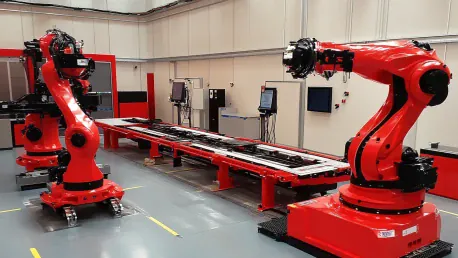The manufacturing sector is undergoing a significant transformation with the advent of AI-powered, self-correcting robotics. These advanced systems are not only reducing downtime but also optimizing operational efficiency and cutting costs across various industries. This article delves into the evolution and impact of these innovative technologies, highlighting their practical applications, the benefits they offer, and the challenges they present.
The Evolution of Manufacturing Robotics
Traditional manufacturing robots were known for their precision but also for their inflexibility. They were designed to perform specific tasks repeatedly, and any deviation or error would halt production. This inflexibility often led to significant delays, as engineers had to diagnose and correct issues manually—a process that could take hours or even days. This resultant unplanned downtime historically cost the manufacturing sector an estimated $50 billion annually. The advent of self-correcting robotics has changed this scenario dramatically, revolutionizing how production lines are managed and operated.
Self-correcting robotics leverage advancements in machine learning, vision AI, and IoT sensors to process vast amounts of data in real-time. These robots constantly monitor their operations, compare actions against predetermined benchmarks, and take immediate corrective actions when deviations are detected. This real-time error-correction capability is at the heart of the innovation, driving significant improvements in manufacturing efficiency and cost management. By addressing errors as soon as they occur, self-correcting robots minimize downtime and maintain a steady production flow, which translates to substantial cost savings for manufacturers.
Practical Applications Across Industries
Industries worldwide are reaping the benefits of integrating self-correcting robotics into their manufacturing processes. In the automotive industry, for example, large manufacturers in the US and Germany use these systems for real-time error detection and correction. A robot assembling a car chassis can identify if a drilled hole is slightly off and adjust subsequent processes accordingly, ensuring continuous production. This ability to self-correct on the fly not only maintains product quality but also significantly reduces the time and resources spent on manual inspections and adjustments.
Similarly, in the electronics sector, self-correcting robots improve accuracy and reduce waste while assembling intricate components like semiconductors. The food and beverage industry uses these robots to handle perishable goods and correct packaging errors promptly, thus reducing waste and complying with safety standards. In the cosmetics industry, such systems ensure the consistency and precision demanded by luxury brands, such as during the lipstick filling process. With each of these applications, the advantages of self-correcting robotics are clear: heightened accuracy, minimized waste, and enhanced compliance with stringent industry standards.
Transforming Workforce Roles
The integration of AI-driven systems is also transforming workforce roles. Contrary to fears of job elimination, these robots shift the focus of employees from constant oversight and crisis management to innovation and system optimization. Engineers and technicians can now concentrate on higher-value tasks, such as improving processes and developing new solutions, rather than performing repetitive troubleshooting tasks. This shift in focus not only enhances overall productivity but also fosters a culture of continuous improvement and innovation.
This transformation underscores the importance of upskilling workers to manage and maintain these advanced systems. Effective training programs and a focus on human-machine collaboration are essential for successful deployment and long-term operation. By embracing these changes, companies can enhance their workforce’s capabilities, drive further innovation, and ultimately gain a competitive edge in the market. Investing in employee development, therefore, becomes crucial as businesses adopt and integrate these sophisticated robotic systems into their operations.
Key Benefits of Self-Correcting Robotics
Several key benefits of self-correcting robotics are driving their adoption across industries. By significantly reducing downtime, these robots prevent financial losses and maintain steady production rates. Enhanced precision in manufacturing processes minimizes material waste and aligns with eco-friendly manufacturing objectives. Additionally, by handling hazardous tasks, these robots contribute to a safer workplace environment, reducing the risk of injuries and ensuring compliance with occupational health and safety standards.
Moreover, self-correcting robotics enable manufacturers to better meet customer demands for high-quality products. With their ability to maintain consistency and precision, these robots enhance product reliability and increase customer satisfaction. As a result, companies adopting these technologies can expect not only cost savings and operational efficiency but also strengthened relationships with their customers and an improved market reputation.
Challenges and Considerations
Despite their numerous benefits, the integration of self-correcting robotics presents some challenges and considerations. For these systems to operate effectively, manufacturers need seamless access to data from various sources, including design repositories and engineering documents. Emerging technologies such as knowledge-mining tools can help bridge this data accessibility gap. Ensuring that robots have access to accurate and up-to-date information is vital for maximizing their error-correction capabilities.
Moreover, manufacturers need to address potential concerns regarding intellectual property. The data collected by these robots could provide insights into proprietary processes, necessitating clear agreements on data ownership and usage to avoid conflicts. Addressing these challenges is crucial for the successful implementation of self-correcting robotics. Additionally, fostering an environment of trust and transparency within the company and with external partners can further smoothen this transition process.
The Future of AI in Manufacturing
The manufacturing industry is experiencing a major shift thanks to AI-driven, self-correcting robotics. These cutting-edge systems are not just minimizing downtime, but also enhancing operational efficiency and slashing costs across multiple sectors. AI-powered robotics in manufacturing are fundamentally changing the way production lines operate. By leveraging machine learning and advanced algorithms, these robots can identify errors in real-time and make adjustments without human intervention, which leads to smoother processes and improved product quality.
Additionally, the implementation of these intelligent systems is resulting in significant cost reductions. Companies can now allocate resources more efficiently and reduce waste, thereby increasing their profit margins. However, despite the many benefits, there are challenges such as initial investment costs, potential job displacement, and the need for ongoing maintenance and updates.
In summary, this transformation in the manufacturing sector heralds a new era of innovation, efficiency, and productivity.









